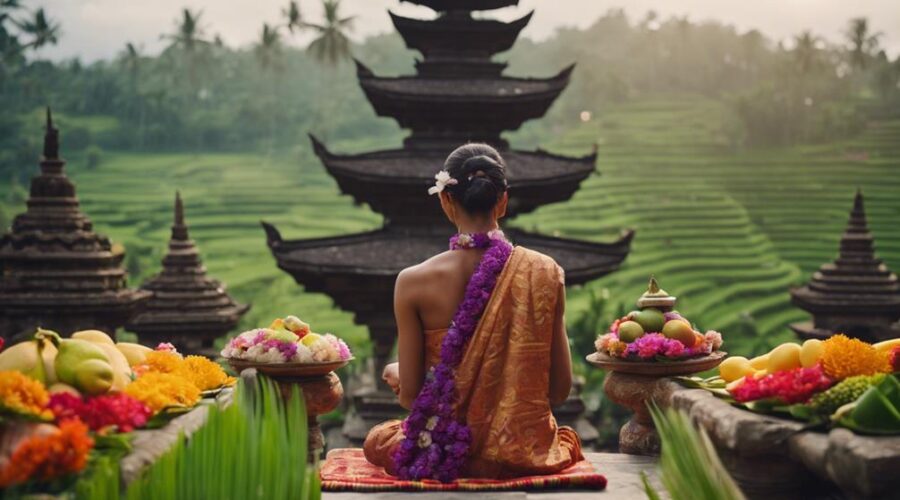What Do Balinese Hindus Believe?
Just as you're pondering the diversity of global faiths, we find ourselves drawn to the unique spirituality of Balinese Hindus. You'd be intrigued to know that their belief system is a fascinating blend of Indian Hinduism, ancient Indonesian traditions, and animistic elements.
They perceive a delicate balance between good and evil, with rituals and ceremonies playing a major role in maintaining this equilibrium. But what makes their deities different? And how do they interpret karma and reincarnation?
Let's explore further and unravel the mystic layers of this enchanting faith.
Key Takeaways
- Balinese Hinduism is a unique blend of Indian Hinduism, Indonesian traditions, Buddhism, and animism, with a strong belief in karma and moral causation.
- Worship involves diverse deities and intricate iconography, with temples serving as pivotal centers and rituals involving offerings and ceremonies.
- Cultural rituals and ceremonies play a crucial role, often involving traditional cuisine, dances, and prayers, especially during holy days of deep spiritual significance.
- The philosophy of Balinese Hinduism, Tri Hita Karana, underscores the importance of harmony and balance with God, nature, and fellow humans, influencing daily life and promoting environmental stewardship.
Understanding Balinese Hinduism
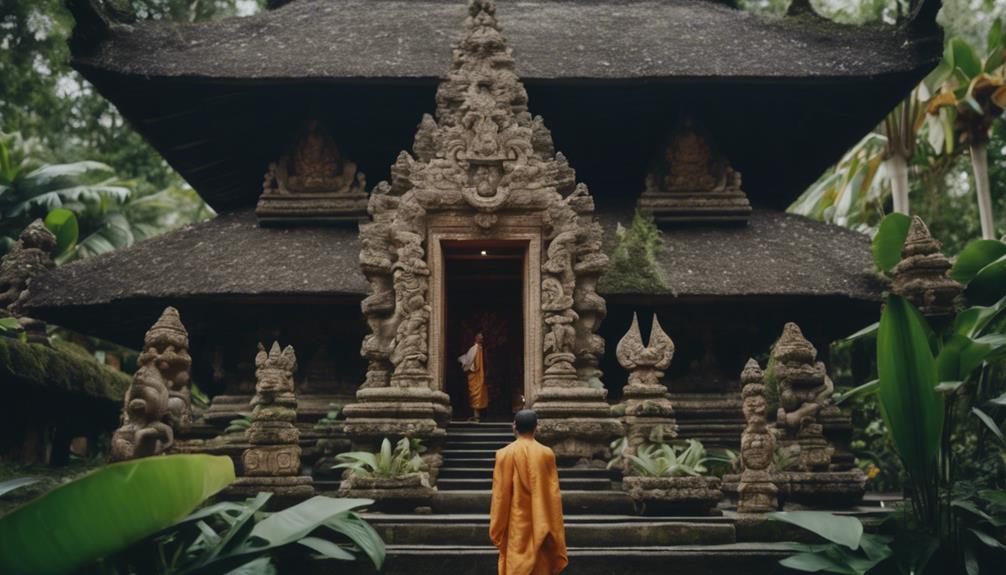
To fully grasp Balinese Hinduism, you'll need to explore its intricate blend of Indian religious traditions and indigenous spiritual practices. This fascinating fusion results in a unique belief system that seamlessly merges Hindu Buddhist elements with Balinese cosmology.
Explore Balinese cosmology, and you'll find a layered universe. Much like an innovative tech startup's multi-tiered organizational structure, Balinese cosmology isn't a flat, one-dimensional concept. It's a dynamic, multi-leveled universe, where different realms of existence coexist. Each level has its purpose and inhabitants, similar to how different departments in a company have specific functions and personnel.
The Hindu Buddhist fusion in Balinese Hinduism is another innovative aspect, a proof of the religion's adaptability. As you know, innovation often involves merging different elements to create something new and effective. In this case, elements of Buddhism and Hinduism fuse to create a unique spiritual framework that's resilient, inclusive, and adaptable.
The fusion doesn't dilute the core principles of either religion. Instead, it enhances them, showing how different philosophies can seamlessly integrate to form a cohesive belief system. Hence, understanding Balinese Hinduism requires an appreciation of this remarkable synthesis and the complex cosmology it upholds.
Balinese Hindu Gods and Deities
Understanding this complex cosmology also means getting acquainted with the pantheon of Hindu gods and deities that are central to Balinese spiritual practices. Balinese deity iconography is diverse and intricate, reflecting the multifaceted nature of the divine. Each deity embodies specific aspects of life, from prosperity and fertility to wisdom and protection.
Balinese Hinduism is a unique blend of Indian Hinduism and indigenous animistic beliefs, a phenomenon known as Hindu-Buddhist syncretism. It's not just a replica of Indian Hinduism; it's a vibrant and dynamic belief system that has been shaped by the island's history and culture. This syncretism is evident in the multitude of gods worshipped, with elements from both Buddhist and Hindu traditions.
Take, for instance, the Tri Murti, the trinity of Brahma, Vishnu, and Shiva. These deities represent the cosmic functions of creation, maintenance, and destruction, respectively. Balinese Hindus also revere Dewi Sri, the goddess of rice and fertility, reflecting the island's agrarian roots. Other deities include Dewa Baruna, the god of the sea, and Dewa Ayu, the god of beauty. Each deity's unique attributes are reflected in their intricate iconography, illuminating their roles in the cosmic order.
The Concept of Karma in Bali
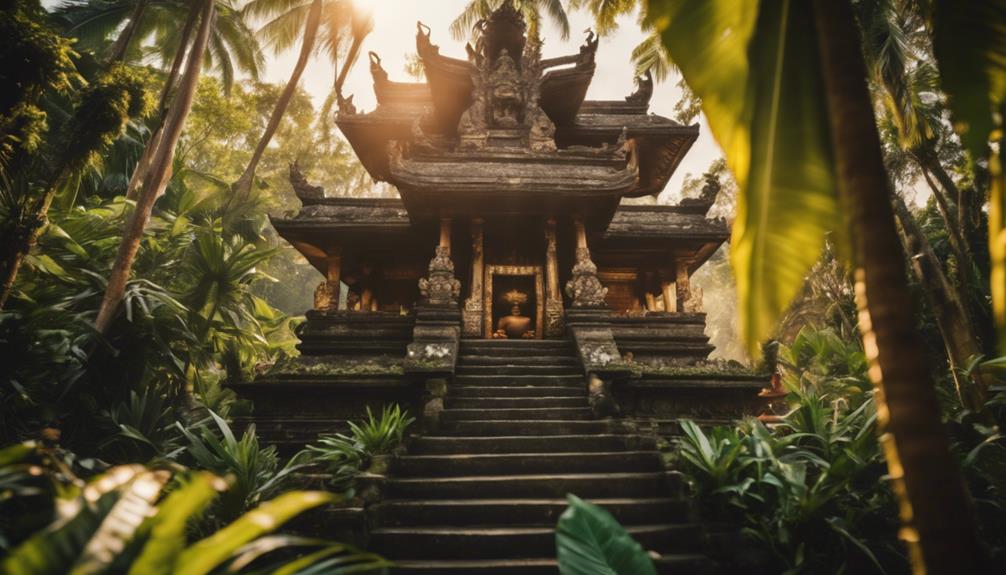
Often, you'll find that Balinese Hindus staunchly believe in the concept of karma, the law of moral causation, which is an integral part of their spiritual beliefs and daily practices. Karma's influence on relationships is profound, shaping interactions and fostering a sense of moral responsibility towards others.
The principle of karma also permeates through the culinary traditions of Bali. Karma in Balinese cuisine is reflected in the mindful preparation and consumption of food, with an emphasis on balance and respect for all life forms.
Let's dive a bit deeper into how this concept influences various aspects of Balinese life:
- Interpersonal Relationships: Karma's influence fosters a sense of moral responsibility, fueling actions that promote harmony and discourage harm.
- Food Practices: The concept of karma encourages a balanced, respectful approach to cuisine. It's not just about what's on the plate, but how it got there.
- Social Responsibility: The belief in karma cultivates an ethic of care and responsibility towards the community and the environment.
Understanding karma's role in Balinese Hindu life illuminates the profound interconnectedness of actions, consequences, and spiritual growth within this culture.
Sacred Rituals and Ceremonies
While the influence of karma is clearly seen in daily life and interpersonal relationships, another significant aspect of Balinese Hinduism is the practice of sacred rituals and ceremonies. These rituals, deeply ingrained in Balinese culture, include elements of sacred cuisine and ritualistic dance, each embodying a unique spiritual significance.
The sacred cuisine, often prepared in a ceremonial manner, is offered to the gods. It's not just about the food, it's the intentions behind it, the blessings it bestows. The ritualistic dance is a performance of storytelling, expressing religious and moral values. It's a mesmerizing fusion of artistic expression and religious devotion.
| Sacred Rituals | Purpose | Emotion Evoked |
|---|---|---|
| Sacred Cuisine | Offering to Gods | Reverence |
| Ritualistic Dance | Storytelling of values | Awe |
| Prayer Rituals | Spiritual connection | Peace |
| Temple Festivals | Community bonding | Joy |
These ceremonies and rituals are crucial to Balinese Hindus, forming an intrinsic part of their religious identity. They're not just traditional practices, they're essential expressions of faith that connect the community, inspire spirituality, and foster a shared sense of cultural heritage. Through these rituals, Balinese Hindus navigate their spiritual journey, fostering a deep sense of interconnectedness with the divine.
The Role of Temples in Bali
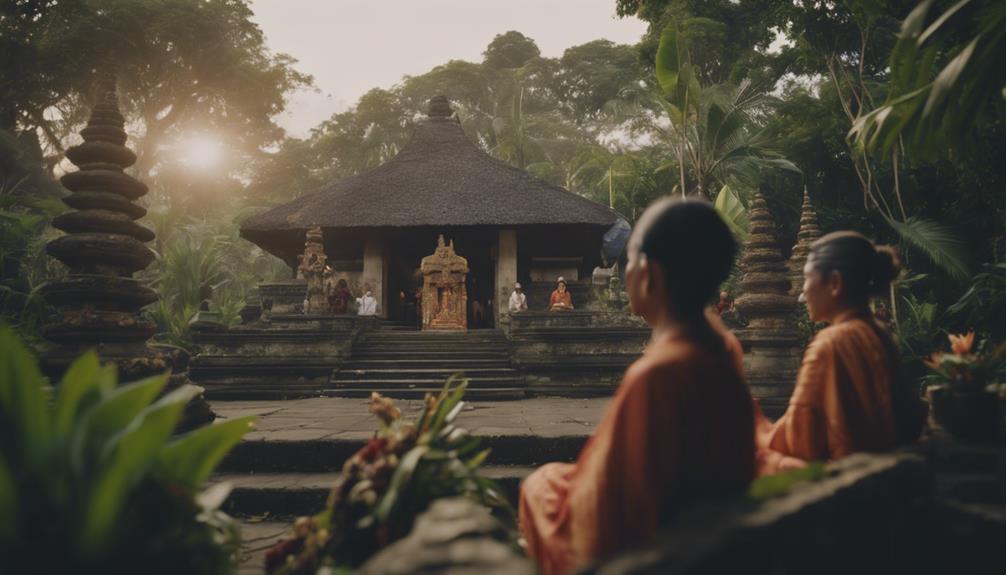
In the heart of Balinese Hinduism, temples play an indispensable role, serving not just as places of worship but also as significant centers for community gatherings and cultural performances. They're more than just buildings; they're the backbone of Balinese culture, representing a blend of art, religion, and community.
The temple architecture is a marvel in itself. The ornate carvings, towering gates, and intricate layouts aren't just artistic expressions, but they represent profound religious philosophies.
Temple-related activities are integral to Balinese life. They're not only places for prayers but also venues for traditional dance performances, meetings, and even educational activities.
In a Balinese pilgrimage, a visit to the temples forms an essential part. It's a spiritual journey, allowing devotees to pay their respects, make offerings, and seek blessings.
- Temple architecture reflects religious philosophies
- Temples serve as community centers
- Temples are focal points in a Balinese pilgrimage
Holy Days and Festivals
You'll find that in Balinese Hinduism, holy days and festivals hold profound significance, serving as key facets of religious expression and cultural identity.
Let's initially explore the most popular festivals, each with its unique rituals and symbolic importance.
We'll also consider the rituals conducted during holy days, shedding light on their intricate ceremonies and the deep-seated beliefs they represent.
Significance of Balinese Festivals
Immersing yourself in the vibrant Balinese festivals offers a profound understanding of the island's unique Hindu beliefs, as each holy day and festival symbolizes a significant aspect of their faith. Festival preparations are meticulous, embodying a deep respect for the divine and showcasing the Balinese's exceptional skill in crafting ornate decorations.
Balinese cuisine also takes center stage, with traditional dishes prepared as offerings and shared among communities. The significance of these festivals extends beyond mere religious observance, fostering community ties and cultural preservation.
Key aspects of these festivals include:
- The meticulous preparation of religious artifacts and offerings
- The role of traditional Balinese cuisine in both ritualistic offerings and communal feasts
- The cultivation of community bonds and reinforcement of cultural identity.
Popular Balinese Hindu Festivals
Often celebrated with great enthusiasm and devotion, popular Balinese Hindu festivals reflect the island's rich cultural heritage and profound religious beliefs. These festivals, such as Galungan and Kuningan, involve extensive festival preparations. The bustling activity and vibrant atmosphere during these times are truly a sight to behold.
The Balinese cuisine plays an important role in these celebrations. Traditional dishes, like lawar and babi guling, are prepared with meticulous care, adding to the festive fervor. These culinary delights not only tantalize the palate but also provide an insight into Balinese culture and tradition.
Rituals During Holy Days
On these sacred occasions, you'll find an intricate array of rituals performed, each carrying a deep spiritual significance and revealing the profound devotion of the Balinese Hindu community. These rituals aren't just symbolic acts, but rather, they're innovative practices that connect the physical world with the divine.
- Ritualistic food offerings: These are central to Balinese Hindu celebrations. Foods are artistically arranged and offered to the deities as a sign of gratitude and to seek blessings.
- Sacred bathing rituals: Participants cleanse themselves physically and spiritually in holy water, symbolizing purification.
- Mantra chanting: This practice involves reciting sacred verses to invoke divine energies and create a spiritual ambiance.
These rituals illustrate the community's innovative approach to maintaining and evolving their rich cultural heritage.
The Importance of Ancestors
In Balinese Hinduism, ancestral reverence carries significant weight. This is reflected in their worship practices, rituals, and even their daily life. Understanding this gives you a deeper insight into how ancestors influence and shape the Balinese Hindu way of life.
Ancestral reverence is a core aspect of Balinese Hinduism. It is not just a cultural practice but a spiritual belief that shapes their worldview and daily interactions. The Balinese believe that their ancestors continue to exist in the spiritual realm and can influence the lives of their descendants. This belief forms the basis of their respect and devotion towards their forebears.
Through rituals, ceremonies, and offerings, the Balinese seek to maintain a harmonious relationship with their ancestors. This connection to their past is deeply ingrained in their identity and plays a crucial role in their social structure and community cohesion. By honoring their ancestors, the Balinese uphold traditions that have been passed down through generations, ensuring continuity and cultural preservation.
Ancestral Worship Practices
Respecting and honoring ancestors plays an essential role in Balinese Hindu beliefs, shaping many of their traditional worship practices. They believe that Ancestor Spirits continue to influence the living, hence, regular offerings and rituals are performed to appease them. Death Ceremonies are considered important events where the soul is released from the body to eventually reincarnate.
In these practices, you'll notice:
- A distinct respect for the departed, underlined by the belief in their continued presence.
- Complex rituals designed around death ceremonies, symbolizing the cyclical nature of life and death.
- The use of offerings in ritualistic practices, reflecting the reciprocal relationship between the living and the Ancestor Spirits.
These practices reveal an innovative take on the traditional concept of ancestral veneration, bridging the gap between the living and the spiritual world.
Ancestors in Rituals
While these beliefs and practices highlight the spiritual connection with the departed, they also underscore the pivotal role of ancestors in Balinese Hindu rituals. Ancestor veneration isn't just a ceremonial act, it's a fundamental part of Balinese Hinduism.
It's a way to maintain a harmonious balance between the living and ancestral spirits. In rituals, offerings are made to these spirits, acknowledging their continued influence and presence. These rites aren't merely symbolically; they're an integral element of their religious life, fostering a deep sense of respect for past generations.
Influence on Daily Life
The reverence for ancestors goes beyond the confines of rituals, permeating the daily life of Balinese Hindus and shaping their worldview. This deep-seated respect greatly influences various aspects of their day-to-day experiences, from Hindu dietary customs to Balinese traditional clothing.
Respect for ancestors manifests in Hindu dietary customs. They believe in consuming foods that honor their ancestors, impacting their dietary choices and meal preparation.
Balinese traditional clothing often features ancestral motifs as a way of preserving and showcasing their lineage.
Even mundane activities like farming or business are influenced, with the Balinese seeking ancestral guidance and blessings for a prosperous outcome.
Essentially, the ancestor's influence is omnipresent, subtly shaping the Balinese Hindu lifestyle in ways that you'd find intriguing and inspiring.
The Tri Hita Karana Philosophy
Incorporating the Tri Hita Karana philosophy, you'll find that Balinese Hinduism deeply values harmony with God, nature, and fellow humans. This guiding principle, rooted in Balinese cosmology, emphasizes the interconnectedness of all life, a concept that fosters religious syncretism.
| Tri Hita Karana Aspects | Implication in Balinese Hindu Life |
|---|---|
| Harmony with God | Spiritual practices, rituals, and devotions aimed at maintaining a balanced relationship with the divine |
| Harmony with nature | Respect and care for the environment as a manifestation of the divine |
| Harmony with fellow humans | Social obligations, community involvement, and respectful interactions |
In the context of Balinese Hinduism, these three aspects aren't isolated beliefs but part of a holistic worldview. They're intricately woven into the fabric of Balinese society, influencing everything from architecture to agriculture, from festivals to family life. Each aspect is seen as equally important, and Balinese Hindus aim to maintain harmony in all three areas. In an ever-changing world, the Tri Hita Karana philosophy serves as a reminder of the importance of balance, fostering a sense of peace and well-being among the Balinese Hindus.
Balinese Hinduism and the Environment
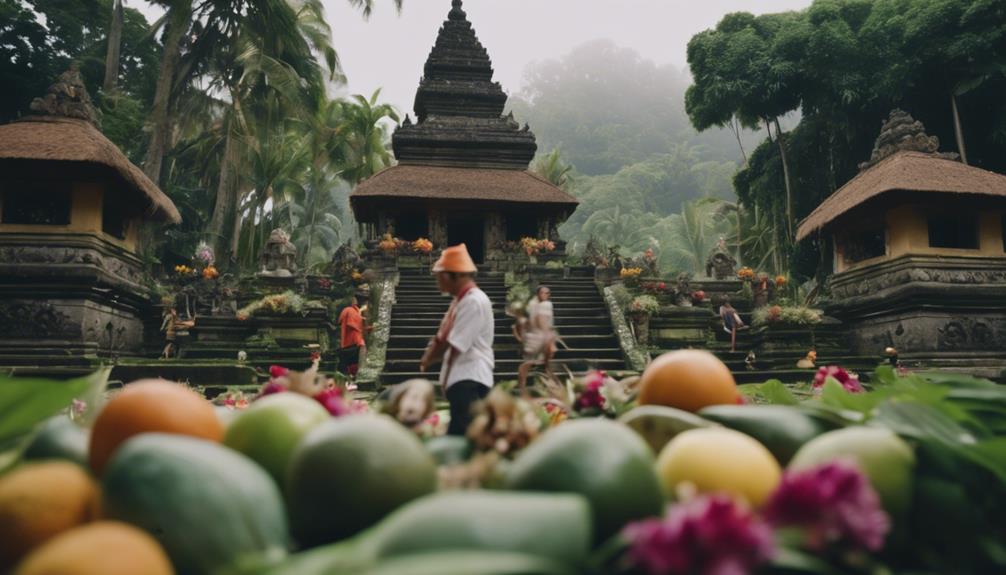
You'll find that Balinese Hinduism's emphasis on harmony with nature manifests in a profound respect for the environment, positioning it as an integral part of religious practices and daily life. This reverence is exhibited in the island's Eco Theology, creating a unique blend of spirituality and environmental consciousness.
Environmental rituals are a cornerstone of this belief system, shaping the way Balinese Hindus interact with the world around them. These rituals aren't simply acts of worship but are designed to maintain a sustainable balance with nature.
To better understand the depth of this connection, consider:
- The ritual of *Tumpek Uduh*, where prayers and offerings are made to plants, underscoring the importance of vegetation in Balinese Hinduism.
- The *Tri Hita Karana* principle, which emphasizes harmony with the environment, among other relationships, fostering a mindset of stewardship rather than exploitation.
- The practice of *Subak*, a traditional water management system for rice fields, reflects an innovative approach to resource management, embodying the sustainable ethos inherent in Balinese Hinduism.
This fusion of faith and environmental respect illustrates how Balinese Hinduism not only values the environment but also offers innovative solutions for maintaining and preserving it.
Art and Dance in Balinese Worship
You'll find that art and dance play integral roles in Balinese Hindu worship.
The symbolism found in traditional Balinese dance provides a rich narrative and spiritual context for these religious rituals.
Art, too, has a profound part, with traditional Balinese craftsmanship elevating the aesthetic and spiritual significance of the worship environment.
Symbolism in Balinese Dance
The intricate movements and vivid dance costumes in Balinese dance serve as powerful symbols, deeply woven into the fabric of Balinese Hindu worship. Each choreography interpretation embodies a spiritual narrative, bringing to life the ancient tales of Hindu deities and mythological creatures.
To make this more engaging, let's explore into some key examples:
- The Barong: Often portrayed by two dancers in an elaborate costume, the Barong represents the good spirit, protecting the village from evil.
- The Rangda: A terrifying witch, symbolizing evil, often depicted with long nails and a large, protruding tongue.
- The Legong: This dance tells a story of royal intrigue, with elaborate costumes and intricate movements, signifying the grace and beauty of Balinese culture.
Through these symbolic dances, worshippers connect with the divine, articulating their faith in a vibrant, kinetic language.
Art's Role in Worship
Immersed in the rich tapestry of Balinese Hindu worship, art and dance don't merely entertain, they serve a pivotal role, acting as conduits for conveying the intricate narratives and profound beliefs of this unique culture. These artistic sacrifices become mediums, creating a bridge between the spiritual and the physical, enhancing the worship aesthetics.
| Role | Art Form | Function |
|---|---|---|
| Communication | Dance | Conveys religious narratives |
| Link | Art | Connects physical and spiritual |
| Enhancement | Aesthetics | Enriches worship experience |
They're not just performances; they're deep, meaningful expressions of faith. You'll find that every gesture, every hue, every rhythm, is meticulously designed to invoke specific emotions and energies, to create an immersive, spiritual experience. Art and dance, as a result, are integral to Balinese Hindu worship, transforming it into a dynamic, engaging, and deeply personal journey.
Traditional Balinese Craftsmanship
Delving into traditional Balinese craftsmanship, it's clear that every aspect, from the intricately carved statues to the meticulously choreographed dances, plays a significant role in facilitating spiritual connectivity and enhancing the worship experience. The Balinese handicrafts' significance isn't merely aesthetic; it represents the divine, the philosophy of life, and the connection between the human and spiritual domain.
- *Balinese statues*: Often depicting gods or mythical creatures, these serve as an intermediary between the worshipper and the divine.
- *Craftsmanship training methods*: Passed down through generations, these techniques are preserved and perpetuated, ensuring the continuance of this spiritual tradition.
- *Balinese dance*: More than entertainment, it's a form of prayer, with each movement having a distinct meaning.
Innovation is key in keeping these traditions alive in the modern world, while still preserving their spiritual essence.
The Balinese Hindu Life Cycle
In understanding the Balinese Hindu belief system, you'll find that their life cycle rituals, known as 'Manusa Yadnya', play an integral role. These Life Cycle Traditions are quintessential and demonstrate the religion's influence on the individual's journey from birth to death.
Right from the Birth Ceremonies, there's a meticulous process that's followed. A newborn is considered pure and holy, and isn't allowed to touch the ground until the 105th day after birth, signifying the child's spiritual readiness to tread the earthly plane.
The life cycle continues with rituals at different stages of life, including the onset of adolescence, marriage, and finally, death. Each phase is marked by specific rites, designed to spiritually guide the individual through life's key milestones.
The Manusa Yadnya isn't merely a set of random traditions, but rather, it's a carefully curated spiritual roadmap. It promotes the concept of Dharma (duty) and Moksha (liberation), encouraging individuals to live virtuously and aspire for spiritual liberation.
In essence, the Balinese Hindu Life Cycle is a compelling proof of the religion's profound influence on the lives of its followers, shaping their individual paths and spiritual journeys.
Balinese Hinduism's Influence on Society
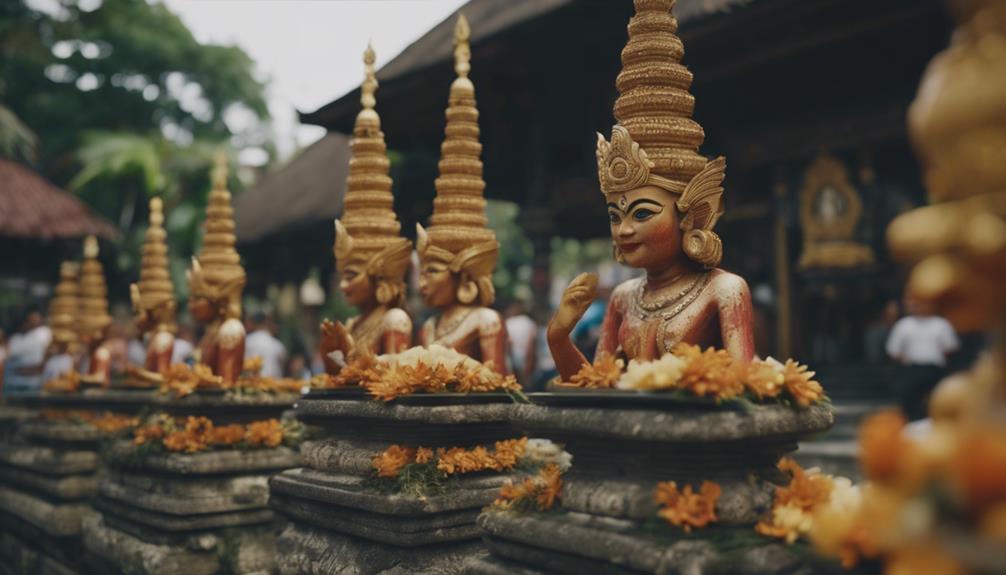
You'd be hard-pressed to find a facet of Balinese society that hasn't been profoundly shaped by Hinduism, from its art, architecture, and music, to its social norms and daily rituals. Their worldview is deeply rooted in Hindu philosophical systems, making it a core aspect of their societal edifice.
In dissecting the impacts, consider these points:
- Hinduism's Impact on Tourism: Balinese Hinduism's unique rituals, vibrant festivals, and stunning temples draw a global audience, boosting the local economy. It's a cultural spectacle that's both immersive and engaging for tourists.
- Art and Architecture: Balinese architecture echoes Hinduism's cosmic principles. Local art is imbued with Hindu symbolism and mythology, demonstrating the religion's profound influence on Balinese aesthetics.
- Balinese Vegetarianism: Hindu principles of Ahimsa (non-violence) have nurtured a robust vegetarian culture. It's not just an aspect of religious observance but also a practice promoting sustainable living and ecological balance.
Balinese Hinduism does more than shaping religious beliefs. It's a dynamic cultural force, influencing societal norms, ethical values, and lifestyle choices. It acts as a catalyst for innovation, driving social transformation while preserving cultural heritage. The result is a society that's deeply traditional yet continually evolving.

